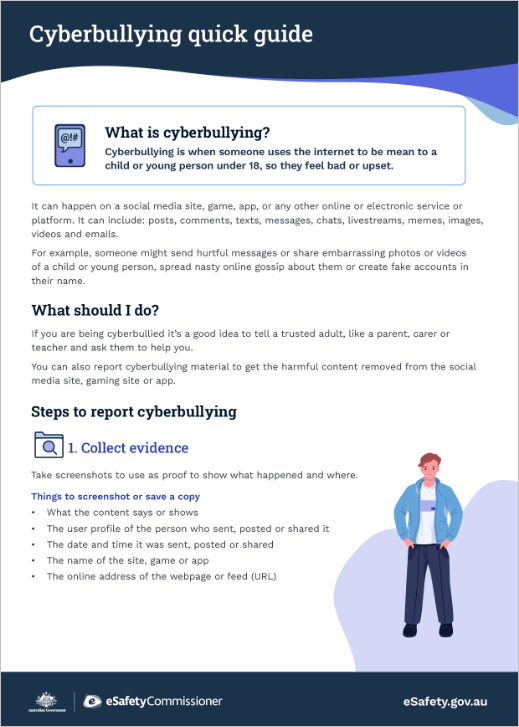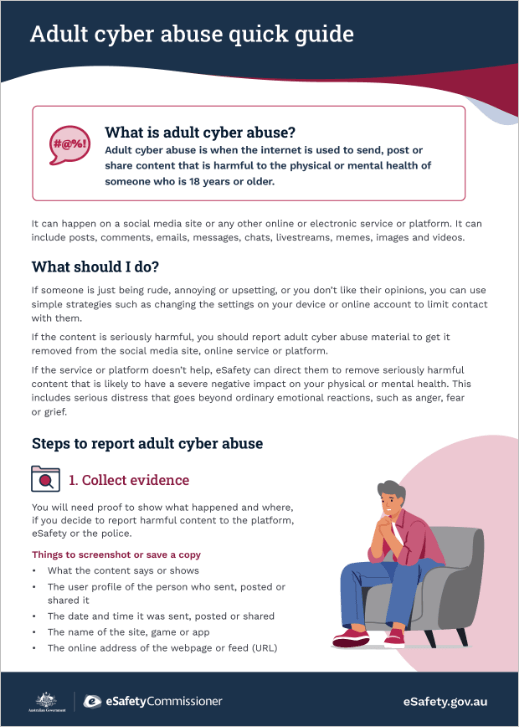Information for Trusted eSafety Providers
Welcome! As a Trusted eSafety Provider, this page offers essential information, tools and resources to support your online safety education program.
On this page:
- About eSafety
- Key resources
- The big issues in online safety
- About eSafety's reporting schemes
- How to report serious online abuse or illegal and restricted content
- Industry regulation
- Support for diverse communities
- Download: guides, posters and social media content
For additional support, email trustedproviders@esafety.gov.au
About eSafety
The eSafety Commissioner (eSafety) is Australia’s independent regulator for online safety. Our purpose is to help safeguard Australians at risk of online harms through regulatory schemes and to promote safer, more positive online experiences. Read more about what we do and how we can help.
Key resources
Trusted eSafety Providers are required to raise awareness of the information and resources available on the eSafety website. These educational materials can inform your program content and be of value to schools that you work with.
The big issues in online safety
Trusted eSafety Providers should stay informed about key online safety issues affecting young people, parents, families and educators.
About eSafety's reporting schemes
Trusted eSafety Providers are required to provide specific information about eSafety’s reporting services where it is relevant to the program and audience.
eSafety administers four reporting schemes under the Online Safety Act that can help remove serious online abuse, and illegal and restricted online content.
Serious online abuse is when the internet is used to send, post or share content that is likely to harm the physical or mental health of the person targeted. This includes:
- cyberbullying of a child or young person (under 18)
- adult cyber abuse (18 years and older)
- image-based abuse (sharing, or threatening to share, an intimate image or video without the consent of the person shown).
Illegal and restricted online content includes material that shows or encourages child sexual abuse, terrorism or other extreme violence.
How eSafety can help
For eSafety to investigate serious online abuse, a report must meet a legal ‘threshold’. This means it must be serious enough to be covered by the scope of the Online Safety Act. Read more about the definitions and thresholds for investigation.
In the most serious cases, when the service or platform does not help, eSafety can:
- direct platforms to remove harmful content sent to or shared about an Australian
- fine or take legal action against a service or platform that refuses to remove harmful content, or the person who sent, posted or shared it
- offer support, including advice on how to protect yourself, deal with the experience, and find counselling and support.
How to report serious online abuse or illegal and restricted content
eSafety treats all reports of online abuse or illegal and restricted content seriously. A report can be made by:
- a child or young person who lives in Australia (but they can be on an overseas holiday at the time)
- a parent or guardian, if they know their child has been targeted by harmful content
- a trusted adult, such as a police officer or teacher, on the child’s behalf.
Collect evidence
This includes the web page address (URL), user profile names and taking screenshots of what has happened and where. Learn more about how to collect evidence.
Report it
Harmful posts, comments, messages and profiles should be reported to the online platform or service first – many of their links are listed in The eSafety Guide. If they don’t help, and the abuse is very serious, report it to eSafety.
Sharing or threatening to share an intimate image or video of a person without their consent is image-based abuse – it can be reported to eSafety immediately unless they’re being blackmailed.
- If they’re under 18 and being blackmailed, the best way to get help is to report it to the Australian Centre to Counter Child Exploitation (ACCCE).
- If they are 18 or older and being blackmailed, they should report it to any platforms or services where the blackmailer contacted them. If their intimate image or video is shared, it can be reported to eSafety for removal. See more advice on our page about how to deal with sexual extortion.
Illegal and restricted online content can be reported to eSafety immediately.
View or download a table of what can be reported and how.
Stop contact
Let the person know they can mute the other account on social media platforms, tighten their security settings and prevent content from being shared further.
For image-based abuse, intimate image or video can also be blocked from being uploaded to some social media and other platforms. The person needs to have a copy of their image or video that will be used to create a digital ‘fingerprint’ or ‘hash’.
- If they are under 18, they can use takeitdown.ncmec.org.
- If they are 18 or older, they can use StopNCII.org.
Get support
Experiencing or helping someone who has experienced serious online abuse can be very disturbing. You may find it helpful to use the strategies we recommend for managing the impacts of cyberbullying of children, adult cyber abuse or image-based abuse or being exposed to illegal and restricted online content. You can also find counselling and support that is right for you.
Industry regulation
eSafety uses its powers to implement and enforce Australia’s online safety laws to protect users from online harms, hold service providers accountable for user safety, and promote more positive digital spaces.
The Online Safety Act (2021) gives eSafety the power to establish a clear set of expectations for online service providers that makes them accountable for the safety of people who use their services. The Act also requires industry to develop new codes to regulate illegal and restricted content.
Basic Online Safety Expectations
The Basic Online Safety Expectations establish a new benchmark for online service providers to be proactive in how they protect people from abusive conduct and harmful content online.
eSafety monitors compliance with the Australian Government’s Basic Online Safety Expectations. These set out reasonable steps that the Australian Government expects certain online service providers to take to ensure Australians can use their platforms safely.
The Basic Online Safety Expectations are backed by new civil penalties for online service providers that do not meet their reporting obligations.
Learn more about the Basic Online Safety Expectations.
Industry codes and standards
eSafety is responsible for overseeing online safety codes for managing illegal and restricted online content. The Commissioner assesses whether the codes developed by industry bodies provide appropriate community safeguards. If so, they are registered; if not, the Commissioner can determine standards instead. eSafety is then responsible for enforcing the industry codes and/or standards.
Phase 1 Industry Codes and Standards regulate Class 1A and 1B material, covering the most seriously harmful online content, including material that shows sexual abuse of children and acts of terrorism. They contain enforceable obligations that apply to eight sections of the online industry.
Phase 2 industry codes are being developed by industry associations to prevent children and young people under 18 from accessing or being exposed to age-inappropriate material. This covers pornography and other high-impact material such as content with themes of suicide, self-harm and serious illness including eating disorders.
People can make a complaint to eSafety if they believe an online service is not complying with a registered industry code or standard for online safety.
Learn more about the industry codes and standards.
Social media age restrictions
The Online Safety Amendment (Social Media Minimum Age) Act 2024 introduces a mandatory minimum age of 16 for accounts on certain social media platforms. The age restriction requirements are due to take effect in 2025.
Learn more about the social media age restrictions.
Safety by Design
eSafety works to address emerging online risks and improve safety measures in digital platforms. As part of this responsibility, our Safety by Design initiative encourages services to integrate safety features into technology from the start, not as an afterthought, but as a core part of platform design.
Learn more about Safety by Design principles and tools.
Support for diverse communities
eSafety's research shows that some people and communities face a higher risk of online abuse and serious harm, due to a range of intersectional factors. These factors include race, religion, cultural background, gender, sexual orientation, disability, and mental health conditions.
Customising program content to address the different needs of participants is also a key theme of the Best Practice Framework for Online Safety Education. This includes addressing topics that are relevant and appropriate, ensuring learning experiences are accessible, respecting student diversity and being inclusive of gender, culture, ability and socio-economic status.
Find information about supporting the needs of your audience using these resources:
Download: guides, posters and social media content
Spread the word about online safety with your networks. Download the resources on this page to access suggested wording and images for social media, newsletters and your website, as well as posters and guides about reporting.
Quick guides
These resources provide key online safety information and steps for reporting cyberbullying, adult cyber abuse and image-based abuse.
The cyberbullying quick guide is also available in Arabic, Punjabi, Simplified Chinese and Vietnamese.
The adult cyber abuse quick guide is also available in Arabic, Dinka, Filipino, Hindi, Korean, Nepali, Persian, Punjabi, Simplified Chinese and Traditional Chinese, Spanish, Thai and Vietnamese.
Reporting flowchart and poster
Click on the file link to download the ‘How to report cyberbullying’ A3 poster and ‘What to do if something bad happens online’ flowchart.
Social media kit
This kit includes suggested posts and images to use on your social media channels, or share with schools and client organisations.
Newsletter and website kit
This kit includes suggested articles and images to use in your organisation’s newsletter or website, or share with schools and client organisations.
Last updated: 15/09/2025


